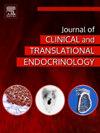左甲状腺素联合缓释三碘甲状腺原氨酸治疗甲状腺功能减退:一项随机临床试验
IF 3.3
Q1 ENDOCRINOLOGY & METABOLISM
Journal of Clinical and Translational Endocrinology
Pub Date : 2025-04-23
DOI:10.1016/j.jcte.2025.100395
引用次数: 0
摘要
一些甲状腺功能减退患者对左旋甲状腺素(LT4)单药治疗缺乏满意度,这可能与血清三碘甲状腺原氨酸(T3)和T3/T4比值较对照组低有关。本研究旨在评价缓释T3 (SRT3)和LT4联合治疗原发性甲状腺功能减退患者与LT4单药治疗的疗效和安全性。方法32例甲状腺功能低下妇女随机分为SRT3 + LT4联合治疗组和LT4单药治疗组。第一组每天给予15µg SRT3和75µg LT4,第二组每天给予100µg LT4,连续8周。在基线和干预后4至8周进行临床和生化测量。结果在4 ~ 8周的研究结束时,LT4组患者血清fT4、T3、TSH水平及T3/fT4比值无明显变化。SRT3 + LT4组fT4、TSH水平明显降低,血清T3、T3/fT4比值明显升高。T3/fT4比值达到与正常受试者相当的值,分别为93.63±23.25和95.06±19.44 ng/ng。SRT3 + LT4治疗8周后,T3/fT4比值上升的10例患者为21% - 90%,5例患者为1% - 13%,1例患者无变化。结论与单纯LT4治疗相比,SRT3 + LT4联合治疗可显著提高甲状腺功能减退患者的血清T3水平和T3/fT4比值。三分之二的患者T3/fT4比值升高≥21%;在SRT3-LT4联合治疗期间,一些患者的T3/fT4比值缺乏显著增加,这需要进一步的研究。本文章由计算机程序翻译,如有差异,请以英文原文为准。
Treatment of hypothyroidism with the combination of levothyroxine and slow-release triiodothyronine: a randomized clinical trial
Background
Some patients with hypothyroidism lack satisfaction with levothyroxine (LT4) monotherapy, which may be related to lower serum triiodothyronine (T3) and T3/T4 ratios compared to control individuals. This study aimed to evaluate the efficacy and safety of a combination therapy of slow-release T3 (SRT3) and LT4 in patients with primary hypothyroidism compared with LT4 monotherapy.
Methods
Thirty-two hypothyroid women were randomized into two groups of SRT3 + LT4 combination and LT4 monotherapy. Group one received a combination of 15 µg SRT3 and 75 µg LT4, and group two received 100 µg LT4 daily for 8 weeks. Clinical and biochemical measurements were performed at baseline and 4 to 8 weeks after intervention.
Results
There were no significant changes in serum levels of fT4, T3, TSH, and T3/fT4 ratio in the LT4 group at the end of 4 to 8 weeks of study. A statistically significant decrease in fT4 and TSH, and an increase in serum T3 and the T3/fT4 ratio, were observed in the SRT3 + LT4 group. The T3/fT4 ratio reached comparable values to those in normal subjects, 93.63 ± 23.25 vs 95.06 ± 19.44 ng/ng, respectively. The rise in the T3/fT4 ratio 8 weeks after SRT3 + LT4 treatment was between 21 % and 90 % in 10 patients and 1 % and 13 % in 5 patients, with no change in one patient.
Conclusion
The novel combination of SRT3 + LT4 therapy resulted in a significant increase in serum T3 and the T3/fT4 ratio in hypothyroid patients compared to those receiving LT4 monotherapy. The rise in the T3/fT4 ratio was ≥ 21 % in two-thirds of patients; the lack of a significant increase in the T3/fT4 ratio in some patients during SRT3-LT4 combination therapy demands further investigation.
求助全文
通过发布文献求助,成功后即可免费获取论文全文。
去求助
来源期刊

Journal of Clinical and Translational Endocrinology
ENDOCRINOLOGY & METABOLISM-
CiteScore
6.10
自引率
0.00%
发文量
24
审稿时长
16 weeks
 求助内容:
求助内容: 应助结果提醒方式:
应助结果提醒方式:


